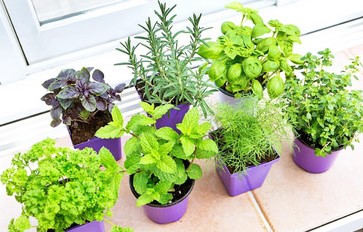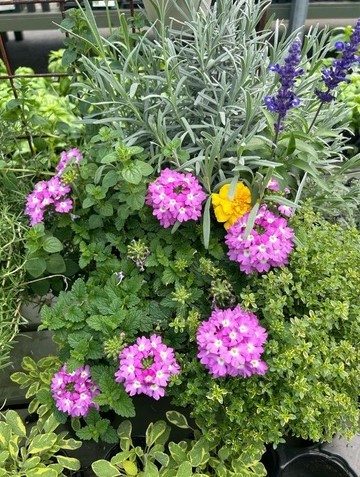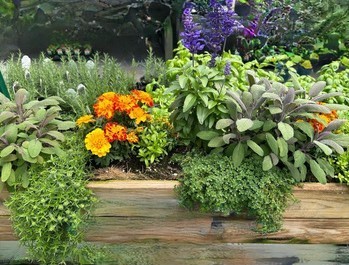by Sue Boehlke, Fulton County Master Gardener Extension Volunteer
This article is part of Garden Buzz, a series from Appen Media and the North Fulton Master Gardeners, where rotating columnists explore horticulture topics like herbs, insects, and wildlife conservation. Find all Garden Buzz articles here.
Herbs are a great way to start food gardening. They tend to be a bit less picky than vegetables, and there are a wide range of choices for various moisture and sun conditions. Many of them also do well in containers, making them a good choice for patios and porches, too.
All herbs should do well in a garden bed except the mint family! Anything in the mint family should only be planted in containers. Mint can spread invasively and take over your bed, your yard and maybe even your house! So, it is best in a pot on its own. It will spread throughout whatever container you choose and choke out whatever else you plant with it. But it is worth the bit of management so you can have it handy to add quickly to water, tea, salads or recipes.

Because mint spreads so quickly, it is very easy to propagate by division or by rooting a cutting in water. It is perfect to receive as a pass-along from a friend or neighbor. Mint will tolerate more conditions than most herbs, including some shade.
In contrast, rosemary can start in a container but will eventually want to be planted in-ground as most forms will result in a large bush if planted in a sunny place.
Mint and rosemary are both perennials. Other herbal perennials that will do well either in containers or in the ground include chives, sage and thyme. Sage and thyme both like drier conditions and work well together as the filler and spiller in a container. Chives are easy to propagate by division, so it is another opportunity to get or receive a starter plant from a friend. Chives like more water and would best be planted with some of the annuals mentioned below.
In most locations in Fulton County, you can harvest these perennial herbs all year long. Harvest times for annual herbs will either be warm season/summer, e.g., basil, or cool season, e.g., parsley.
Many annual herbs can be grown in a container, but check the label as some of them, like santolina, tarragon and dill, will like a big container best. Parsley is easy to grow and can tolerate some shade, so it is a great filler for a planter with other herbs or flowers. While basil loves to get big in the ground, it behaves well in containers, too, and makes a great thriller for your container arrangement.
When planting your containers:
- Select an appropriately sized planter for the number of herbs you are including. Clay pots are a good place to start, but you can be creative. Ensure they have drainage holes, and you have placed them in areas that receive the right amount of sun. It is easier to move them to their final location before you add the soil. In some cases, you may want them on wheels so they can be moved.
- It is always handy to have some herbs right near the kitchen door so you can easily just “snip and go” when you need them for recipes.
- The containers should be filled with a good potting mix. (Not from your yard or “garden soil” from the store.)
- It is easier to start with small plants from the garden center or a friend than with seeds if you are a new gardener.
- If you plant basil and chives that have big crops and lots of harvest, you will occasionally need to add fertilizer throughout the growing season.
- Water appropriately for the herbs in that container. You should save the tags they come with when you purchase them as a reminder of the sun and water requirements as well as to predict their eventual size.
- Harvest throughout the growing season. You do not want your herbs to bloom with flowers or you will lose flavor, as they put their energy into flowers and seed instead of flavor in the leaves.


When planning your containers, remember that herbs do not need to be exclusive. You can mix them with other vegetables, small shrubs (depending on container size) or even flowers (foodscaping is the practice where food is incorporated in your decorative landscape). It is important to have consistent water and sun requirements for all plants in a particular container so they can thrive. Keep in mind the eventual size and shape of the plants you select so you do not under- or overplant.
Happy Gardening!
Learn More

This week’s “Garden Buzz” guest columnist is Sue Boehlke, a master gardener intern. Sue is a member of the North Fulton Master Gardeners. She graduated from Northwestern University with a degree in Economics and an MBA. She is a lifelong, avid gardener and is now working on the challenge of downsizing her gardening to a small city lot in Alpharetta, where fungus, pests and weeds still find her.